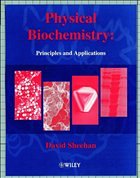Nicht lieferbar

Physical Biochemistry
Principles and Applications
Versandkostenfrei!
Nicht lieferbar
Weitere Ausgaben:
"Physical Biochemistry" ist eine Sammlung der grundlegenden physikalischen Ansätze, die gegenwärtig benutzt werden, um die Struktur und Funktion komplexer Biomakromoleküle, wie z. B. Proteine und DNA, zu beschreiben. Die revolutionären Fortschritte in der Molekularbiologie haben hochauflösende Analyseverfahren erforderlich gemacht, mit deren Hilfe diese Biopolymere und die Wechselwirkungen zwischen ihnen untersucht werden können. Dieses Buch behandelt folgende Analyseverfahren: die Spektroskopie, Chromatographie, Röntgendiffraktion, Zentrifugation und Biokalorimetrie. Es erläutert neue...
"Physical Biochemistry" ist eine Sammlung der grundlegenden physikalischen Ansätze, die gegenwärtig benutzt werden, um die Struktur und Funktion komplexer Biomakromoleküle, wie z. B. Proteine und DNA, zu beschreiben. Die revolutionären Fortschritte in der Molekularbiologie haben hochauflösende Analyseverfahren erforderlich gemacht, mit deren Hilfe diese Biopolymere und die Wechselwirkungen zwischen ihnen untersucht werden können. Dieses Buch behandelt folgende Analyseverfahren: die Spektroskopie, Chromatographie, Röntgendiffraktion, Zentrifugation und Biokalorimetrie. Es erläutert neue Entwicklungen anhand der physikalischen Prinzipien, auf denen sie basieren und diskutiert eine breite Palette der am häufigsten angewandten biophysikalischen Ansätze. Dabei wird auch auf allgemeine Gemeinsamkeiten im experimentellen Ansatz eingegangen. Jedes Kapitel enthält eine Bibliographie zu weiterführender Literatur sowie Texte und Websites. Darüber hinaus gibt es zahlreiche Beispiele und historische Hintergrundinformation zu den verwendeten Techniken. (y05/00)
An accessible and easy-to-read text for students requiring a broad overview of the key techniques used to characterise the structure and function of complex biomacromolecules such as proteins and DNA. It bridges the gap between general biochemistry textbooks and the more specialist texts covering individual techniques.
Topics covered include chromatography, spectroscopy, mass spectrometry, electrophoresis, X-ray diffraction, centrifugation and biocalorimetry. New developments are placed in context by describing the physical principles on which they depend, examining the range of biophysical applications most widely used and, emphasising the overall similarities of experimental approach.
Written by a biochemist with extensive teaching experience, the book:
* describes the advantages and disadvantages of each technique and compares one technique to another;
* introduces experimental approaches in a non-mathematical way, using practical examples; and
* provides a bibliography, including useful web sites, at the end of each chapter.
This book will be invaluable to undergraduates and postgraduates studying biochemistry, molecular biology and related disciplines.
"As will be seen, there is not much missing here. I thought that the sections were well balanced, with rarely too much or too little on a given topic....This is a text to be welcomed by both teachers and students." (Biochemistry & Molecular Biology Education, No.29, 2001)
"the explanations are really clear" (Nahrung/Food Vol.45, No.4, 2001)
Chromatography.
Spectroscopic Techniques.
Mass Spectrometry.
Electrophoresis.
Three-Dimensional Structure Determination of Macromolecules.
Hydrodynamic Methods.
Biocalorimetry.
Appendices.
Index.
An accessible and easy-to-read text for students requiring a broad overview of the key techniques used to characterise the structure and function of complex biomacromolecules such as proteins and DNA. It bridges the gap between general biochemistry textbooks and the more specialist texts covering individual techniques.
Topics covered include chromatography, spectroscopy, mass spectrometry, electrophoresis, X-ray diffraction, centrifugation and biocalorimetry. New developments are placed in context by describing the physical principles on which they depend, examining the range of biophysical applications most widely used and, emphasising the overall similarities of experimental approach.
Written by a biochemist with extensive teaching experience, the book:
* describes the advantages and disadvantages of each technique and compares one technique to another;
* introduces experimental approaches in a non-mathematical way, using practical examples; and
* provides a bibliography, including useful web sites, at the end of each chapter.
This book will be invaluable to undergraduates and postgraduates studying biochemistry, molecular biology and related disciplines.
"As will be seen, there is not much missing here. I thought that the sections were well balanced, with rarely too much or too little on a given topic....This is a text to be welcomed by both teachers and students." (Biochemistry & Molecular Biology Education, No.29, 2001)
"the explanations are really clear" (Nahrung/Food Vol.45, No.4, 2001)
Chromatography.
Spectroscopic Techniques.
Mass Spectrometry.
Electrophoresis.
Three-Dimensional Structure Determination of Macromolecules.
Hydrodynamic Methods.
Biocalorimetry.
Appendices.
Index.



